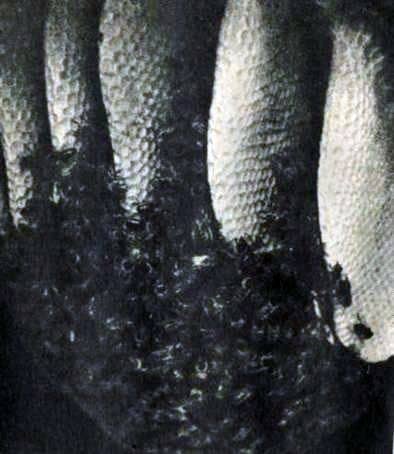
Then came late autumn. Became shorter and cooler days. Trees and shrubs discard the yellowed leaves. With the withering of nature, the activity of honey bees gradually decreases. They, like the plant world, are preparing for a long period of winter peace. Only on fine days the bees fly out of the hives in search of nectar and pollen from late flowering plants – sweet clover, meadow cornflower, rape.
Every day the uterus reduces egg production. The last generations of brood mature. Gradually, the work ends in the nests.
Around the brood the bees are bored, grouped in a more dense mass, supporting the temperature necessary for the larvae in this brood zone, carefully feeding them.
In shape, this mass of bees resembles a ball or a large ball. Beekeepers are called – the club of bees. With the onset of cold weather, the bees seem to shift to the winter form.
Like all social insects, honey bees do not hibernate in winter, but live a normal life – they eat and move. Since the temperature of their body is variable and depends on the temperature of the air, they, in order to keep warm from each other, get lost in a heap.
The club is usually located at the bottom of the hive on empty honeycomb, where you can pull closer to each other, not far from the tap, where fresh air comes from. Only the insects at the top of the club are close to honey. But if in the fall a warm sunny day falls, the club disintegrates and the bees, apparently, also on some signal fly out of the hive.
The autumn circumnavigation is short, amicable, with a special sad, farewell ringing. Bees seem to be in a hurry to take advantage of short-seed heat. This autumn they are not far from home. As soon as the sun goes behind the cloud, they immediately return home.
A short, at least a few minutes, flight from the hive to the bees to cleanse the intestines. After all, they do not defecate in their nest, but do it in the air, during the flight, away from their home. And ahead of them a multi-month winter. Obeying the instinct of self-preservation, bees usually do not miss the chance to fly around in late autumn. If the bees are released from the slag in the autumn, they will be much easier to hibernate. Moreover, the later fly over, the better.
A beekeeper can help bees, his winged friends, when preparing them for the winter. For example, place the hives in a place protected from winds by vegetation – trees or shrubs, high hedges or buildings, hilly terrain. In the apiary, this is quieter and warmer. In addition, you need to deploy the hives. If in the summer they were located by the gates to the east or north to reduce the heat, they are gradually turning to the south side by the autumn.
On sunny days, especially at noon, the front walls of the hives heat up, the home warms, the heat excites the bees in the club. They are affected by sunlight passing through the ice. All this accelerates the release of bees from the hive for an autumn flight.
In the steppe areas, where winds often blow, the beehives are wrapped in autumn or winter with black wrapping paper or roofing paper. A dark wrap helps to warm up the hives quickly.
If the inclement weather has dragged on and the bees have already fallen into deep peace and are in a dense club, they do not always respond quickly to short-term heat. In such cases, it is necessary to open the tapes wider, even disturb the bees, to make them become more active. Sometimes they remove roofs and pillows so that the sun warms the nests from above.
In the central region of the country, overflights are possible in late October – early November. In the south, bees fly in the winter, and in Siberia they do not leave the hives for 6-7 months.
Начинающему пчеловоду. Растение кустарниковые.
Young Beekeeper